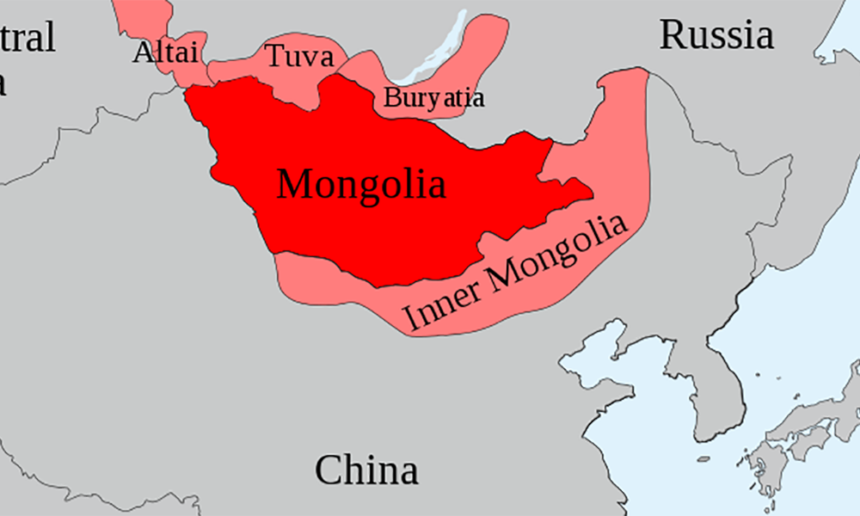Aero Mongolia’s Fokker 50 flew over Hohhot, the capital of Inner Mongolia Autonomous Region, at least twice while waiting for its turn to land.
When it touched down at the Tsagaan Suvarga airport, some turbulence was felt due to wind, or maybe because it had just rained. It was clear from above the city I had visited 10 years ago, and which has now changed significantly. Hohhot is full of modern roads stretching many kilometers, and looks completely green. An Inner Mongolian gentlemen sitting next to me said that the Chinese say that if you want to get wealthy, fix the roads. He further elaborated, “Every settlement in Inner Mongolia is connected with roads and railways today.”
The name “Hohhot” (Blue Rock) comes from the history of Altan Khan having a blue rock brought from the Dalan Khar Mountains and a temple built to hold it in 1557. Today, Hohhot has a population of three million people and one million vehicles. Having developed at a rapid rate, Hohhot has already grown into the governance, political, cultural, and arts center of the region. One third of Hohhot’s 17,000 square meters is green. A total of 24 parks ensure that people breathe fresh air, have space for exercise, and enjoy a good environment for dancing. This year alone, they are building eight more parks. There are over four million Mongolians and 20 million Han Chinese living in Inner Mongolia today. Their GDP per capita is 10,000 USD – the same as Chile’s.
‘ONE BELT, ONE ROAD’ BUSINESS PLAN
Within one generation, or 30 years, China has managed to turn from a poor country with an agricultural economy into a global industrial leader. China’s economic model allowed them to invest domestically, develop industries, and export products to developed countries. As a result, China is now the second biggest economy in the world – only behind the United States. It is only recently that their economic growth has started slowing down. In response, China began seeking ways to address the growing demands of its neighboring countries and markets to take full advantage of their industrial capacity and maintain economic growth. This is the reason why Xi Jingping, President of China, when visiting Kazakhstan exactly three years ago, on September 7, 2013, announced that European and Asian countries could build the Silk Road Economic Belt.
This idea to revive the historical Silk Road, along which Asia and Europe exchanged silk, tea, and other products for hundreds of years, has now become a business plan called the One Belt, One Road Initiative. The plan has two key components, one of which is the land-based Silk Road Economic Belt, connecting over 60 countries of these two continents and accounting for 60 percent of the global population and one third of global GDP. The other is the Maritime Silk Road, connecting Asia and Europe by ocean. The realization of these plans require far-sighted and comprehensive political vision, long term investment, and – most importantly – political stability from all the countries that will be connected by the revived Silk Road.
If we look at how the initiative’s investment is going, China has worked on it with 56 countries, and has established the Asian Infrastructure Investment Bank and pulled together almost two trillion USD in cash at China Development Bank.
MONGOLIA’S CORRIDOR
China has put forward a grand plan to develop its economic cooperation and build economic corridors in seven directions by working with neighboring countries. These will be based on the principles of partnership and connectivity. In terms of economic corridors to the north, Mongolia’s geographic location is deemed significant. Mongolia is sandwiched between Russia and China, and has a territory that fits into a rectangle that is 2,400 km in length and 1,260 km in width. It has been established by all parties that going around Mongolia does not make sense.
If you go around to the east, it is only significant in the region. If you go the west, you will face the Altai Mountains, and it would be too expensive to build roads there. As of today, it has already been several years since discussions started on building three roads and three railways across Mongolia, and developing oil, power, and communication corridors in the country. All these corridors would go through Inner Mongolia and help them develop more rapidly. For this reason, Hohhot wants to implement the plan at a steady pace.
We already have a mechanism where the heads of state of Mongolia, Russia, and China have regular meetings. This has helped push progress on Steppe Road (Mongolia refers to the corridor as the Steppe Road) projects and has facilitated engagement between China and Mongolia’s ministries and agencies. However, the work to build corridors in the other six directions is behind schedule. Today, Mongolians have to build narrow gauge railway to the south and broad gauge railway to the north.
Three and a half years ago I proposed in my article “Mongolia is the Next Panama” that we should build a Ж-shaped railway network and use mixed gauges on the horizontal rails so that Russian and Chinese trains would not have to change their wheels when going in and out of Mongolia.
Today we need to follow the principle of all corridor projects being advantageous to each of the three countries, maintain our attitude, and accelerate the work without losing time. It was discussed during the ASEM Summit recently held in Ulaanbaatar that global development is unfathomable without the trade and transport developed between Asia and Europe. It is now time to discuss the social and environmental impacts of these big projects, reach agreements, and start construction.
Hohhot – Ulaanbaatar, 2016.09.14
Trans. by B.AMAR







